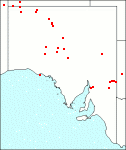Family: Poaceae
Enneapogon intermedius
Citation:
N. Burb., Proc. Linn. Soc., Lond. 153:67, 68 (1941).
Synonymy: Not Applicable Common name: Tall bottle-washers.
Description:
Perennial 30-70 cm high, with a pubescent slightly thickened base; culms branched, hirsute with mainly simple hairs; leaves pubescent with mainly glandular hairs; blades involute, acute, scabrous.
Panicle 3-13.5 x 1.5-2.5 cm (including the awns), spike-like, pubescent with glandular hairs on the peduncle, axis and branches; spikelet 3-6-flowered with 2 florets fertile; glumes membranous, lanceolate or oblong to ovate or elliptic, acute or obtuse, entire or erose, pilose near the margins or hispid with glandular hairs; lower 3.5-7 mm long, 7-16-nerved; upper 4.5-8.5 mm long, 6-11-nerved; lowest floret: body 2.2-3.6 mm long, hardened, smooth or the nerves slightly corrugated, bearded with hairs longer than the body itself, glabrous or sparsely ciliate on the margins; awns 3.6-9 mm long; palea of lowest floret: body pubescent on its greater part; flaps hirsute; keels ciliate in the upper part, glabrous below; grain 1.3-2.2 x 0.8-1.6 mm, broadly obovoid; second floret: similar to the first though smaller; lemma with a basal tuft of hairs or glabrous; third floret: sterile, with a glabrous lemma and a pubescent palea; rhachilla sparsely pubescent.
Published illustration:
Cunningham et al. (1982) Plants of western New South Wales, p. 95.
|
|
Distribution:
|
S.Aust.: NW, LE, FR, EP, NL. All mainland States except Vic.
|
Conservation status:
native
Flowering time: No flowering time is available |

SA Distribution Map based
on current data relating to
specimens held in the
State Herbarium of South Australia
|
Biology:
Previously confused with E. polyphyllus, which E. intermedius closely resembles, but in the former species the palea is glabrous in the upper one-half to two-thirds, only 1 floret is fertile and the structure of the sterile florets is quite different.
Author:
Not yet available
|

